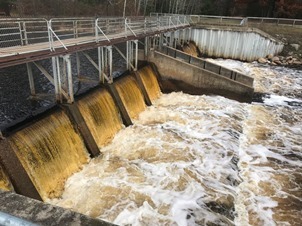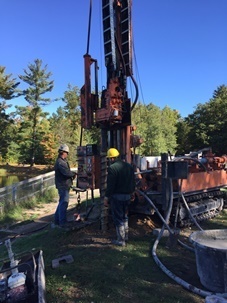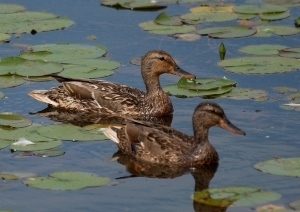|
May 30, 2018
Contact: Keith Fisher, 989-275-5151, ext. 2722031 or Vern Richardson, 231-429-6838
Reedsburg dam in Missaukee County set to undergo significant maintenance upgrades; preparation starts this summer
Area’s popular state forest campground will remain open, but visitors will notice construction activities and a lower water level due to flooding drawdown
 Visitors this summer to the Reedsburg dam state forest campground and the nearby flooding in Missaukee County will see a lot of activity and notice some landscape changes tied to planned structural improvements on the dam and surrounding area. The work, once completed, is designed to provide a safer and richer outdoor recreation experience for the many anglers, birders, waterfowl hunters, kayakers, campers and other outdoor enthusiasts who regularly flock to this area.
The Michigan Department of Natural Resources’ decision to upgrade the Reedsburg dam stemmed from a broader evaluation of a number of dams throughout the state. A 2016 inspection of the Reedsburg dam – one of the largest structures on the list – showed the structure to be in fairly good shape, but that some priority actions needed to be addressed. The Wildlife Division decided to start with:
- The restoration of the earthen dike adjacent to the dam.
- Repairs to the structure’s concrete and steel components.
- Replacement of the stoplogs (the hydraulic engineering elements that control water levels) and the stoplog mechanism that has been in disrepair for years.
|
According to Keith Fisher, a wildlife biologist who works out of the DNR’s Roscommon office, the department has submitted a wetland permit application to the Department of Environmental Quality in order to begin work on the dam. If the permit is approved, the first step, is a drawdown of the Reedsburg flooding and pond surrounding the dam, anticipated to start in August. Lowering of that water level will expose the dam structure and areas where repairs and construction work are needed. The permit will include specifications for water discharge rates and protection of fish as the water level is lowered.
“The drawdown of the flooding area is a necessary first step, simply to expose all areas where repairs are necessary,” said Fisher, who is coordinating the DNR’s role in the project. “It will take about a month for the drawdown to be completed. Starting in August gives us the time needed to dry out the area where work will be done, while minimizing the inconvenience to campground visitors.”
 Reedsburg dam history, maintenance
The Reedsburg dam was built on the Muskegon River in 1940 to create wetland habitat for a variety of wildlife species. Primarily focusing on waterfowl and furbearing species, the dam created a flooding that encompasses about 540 acres.
Over the years, the DNR conducted regular maintenance that has kept the dam in good working order, but – given the dam’s age – it was prudent to have a comprehensive structural evaluation done. In 2016 a professional engineering firm was contracted to inspect the dam and earthen dike. This study included all aspects of the site, including soil borings, structural conditions, and even a dive team that handled underwater inspections.
“Duck hunting, trapping, fishing, bird watching, canoeing, kayaking and camping at the adjacent state forest campground are just some of the activities made possible by the Reedsburg dam installation and eventual flooding,” Fisher said. “Those activities now consistently draw people to the area, and we want to ensure the Reedsburg dam’s structure and integrity will continue to provide safe, quality outdoor recreation experiences for everyone.”
|
 Next steps
Once the DEQ approves the wetland permit, drawdown of the Reedsburg flooding can begin. The DNR expects to begin the drawdown in August, start construction in the fall and continue that work throughout the winter and spring, and then add water back to the flooding in mid-summer 2019.
In order to complete these repairs, the Reedsburg flooding will have to be mostly free of water during construction. Only the normal flow of the Muskegon River will be moving through the project during construction.
How will the public be affected?
Visitors to the Reedsburg flooding and campground area – especially waterfowl hunters – can expect to see extremely low water levels. There also will be reduced or restricted access to the dam, dike and the parking area throughout construction. This will include access to the maintenance walkway across the top of the dam that many people have used to get to state-managed land to the south.
Guests at the Reedsburg state forest campground (which will be open during the dam construction project) may experience some noise disruption from surrounding work. The boating access site ramp also will be open for use, but the flooding’s water drawdown likely will limit the areas that boaters can reach, until the water level is restored next year.
“We understand this project will affect some outdoor recreational activities popular at the Reedsburg flooding,” said Joshua Pellow, manager of the Reedsburg dam state forest campground. “We sincerely hope that visitors will understand these are necessary repairs and that a short disruption now will provide many worthwhile benefits far into future.”
|
 Effect on wildlife, future outdoor recreation
A water drawdown of a flooding yields many positives for a wetland area, and Fisher said that is why they’re done periodically at managed wetland areas around the state.
“Drawdowns expose moist soils that otherwise don’t see sunlight, and that creates ideal conditions for dormant seed banks to germinate and increase wetland plant diversity,” he said. “Like a chain reaction, better plant diversity attracts a more diverse insect community, and then an increasingly wide variety of wildlife species.
“Freshly exposed mud flats are a magnet for shorebirds, too, and that provides incredible opportunities for bird watchers to see many different species in one area.”
Overall, drawdowns like the one planned for the Reedsburg flooding are in the best long-term interest of wildlife and habitat in that area, which means better outdoor experiences for residents and visitors, too.
To get more information about the planned Reedsburg dam construction project, contact Keith Fisher at 989-275-5151, ext. 2722031 or local DNR wildlife biologist Vern Richardson, 231-429-6838
|
/Note to editors: Accompanying photos are available below for download. Caption information follows.
Reedsburg_Dam_evaluation_equipment_Oct_2016: Soil borings from around the Reedsburg Dam in Missaukee County were collected to determine the composition and soil layers associated with the earthen berm. This information helped engineers develop specific plans for needed repairs.
Reedsburg_Dam_evaluation_Oct_2016: Diver exiting the water surrounding the Reedsburg Dam after examining underwater sections of the dam (October 2016).
Muskegon_River_kayakers: The Reedsburg Dam state forest campground in Missaukee County draws people to the area for a variety of outdoor recreation fun, including kayaking and canoeing.
Waterfowl: Waterfowl is just one example of wildlife that will benefit from work like that being done this year at the Reedsburg Dam and flooding area in Missaukee County./
|